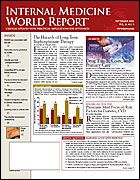Publication
Article
Internal Medicine World Report
Testosterone-containing Therapies Increase Breast Cancer Risk
Author(s):
Results of a new clinical study add support to the growing evidence that taking estrogen and testosterone (E&T) therapies can increase a woman’s risk of developing invasive breast cancer (Arch Intern Med. 2006; 166:1483-1489).
The prospective analysis of a cohort from the Nurses’ Health Study included 121,700 women (aged 30-55 years) and took place from 1978 to 2002. The goal was to ascertain the risk of breast cancer related to different types of postmenopausal hormone replacement therapy (HRT).
Every 2 years, questionnaires were sent to update information on menopausal status, HRT use, and breast cancer diagnosis. The initial small proportion of women in this cohort who reported current use of E&T therapy increased considerably over the course of the study.
During the first 10 years of follow-up, the number of women who said they were currently using E&T therapy increased by more than 8-fold, from 33 women in 1988 to 550 women in 1998. By the year 2000, E&T therapy accounted for 2.2% of all currently used HRT.
During the 24 years of follow-up, a total of 4610 incident cases of invasive breast cancer occurred in postmenopausal women. Overall, current users of E&T therapy had a 77% increased risk of developing breast cancer compared with women who had never used HRT. In comparison, risk of breast cancer among current users of estrogen-only therapy was 15% greater than among never users. Women who used E&T therapy were also at increased risk of breast cancer compared with those who used estrogen-only therapy (P = .03).
All the risk assessments for hormone users were greater when restricted to women who had un-dergone natural menopause. Such women who were current users of E&T therapies had a 2.5-fold greater risk of breast cancer compared with women who had never used HRT. The risk of breast cancer with current use of E&T therapy was also significantly greater than with estrogen-only therapy (P = .007) and slightly greater than with estrogen and progesterone therapy (P = .11).
Lead author Rulla M. Tamimi, ScD, of Brigham and Women’s Hospital and Harvard Medical School, Boston, and colleagues write, “Given the substantial evidence implicating combined E&P [estrogen and progesterone] therapy in breast cancer and the results of the present study regarding E&T therapies, women and their physicians should reconsider use and, more specifically, long-term use of these therapies.”
They add that this increased risk for breast cancer may outweigh any benefits related to sexual function, quality of life, or bone health.






